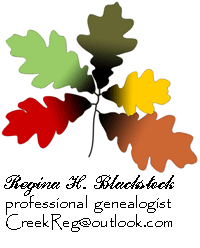Elizabeth English Ward, DNA Testing
Within recent years, many have opted to use DNA testing to prove their heritage. They were disappointed when their results failed to show Native American ancestry. Unfortunately, most stop there and do not research “why?” – specifically:
- Autosomal DNA Test, by far the cheapest and most popular, analyzes all 23 pairs of chromosomes inherited from both parents and attempts to match chromosome segments to known Native American segments. This DNA test is advertised for its ability to determine family origins and provide percentages of ethnicity. As a result of the following two limitations, this test will provide negative results for Elizabeth’s living descendants:
- Chromosome segments “wash out” or “dilute” with each generation. Each of Elizabeth’s children received approximately 50% of her chromosomes and 50% of their father’s chromosomes. Her grandchildren receive only 25% of her chromosomes (50% from each parent means her grandchildren receive only ½ of the 50% she contributed to her children). With each generation her remaining DNA is split in half when it is passed to the next generation. Most of Elizabeth’s descendants living today are six or more generations removed – which means less than 1.56% of their chromosomes were received from Elizabeth. Furthermore, many of these segments may be too fragmented to match.
- In order for the Autosomal DNA Test to accurately identify Creek Indian (or any other heritage), research must be conducted to identify chromosome segments unique to that population. To date, no federally recognized tribe has endorsed or participated in DNA testing.1 Furthermore, Creek Indians were historically a confederacy of many ethnic groups (such as Hitchiti, Yuchi, Muskogee, Choctaw, etc.) with each having their own language and unique DNA.
- Chromosome segments “wash out” or “dilute” with each generation. Each of Elizabeth’s children received approximately 50% of her chromosomes and 50% of their father’s chromosomes. Her grandchildren receive only 25% of her chromosomes (50% from each parent means her grandchildren receive only ½ of the 50% she contributed to her children). With each generation her remaining DNA is split in half when it is passed to the next generation. Most of Elizabeth’s descendants living today are six or more generations removed – which means less than 1.56% of their chromosomes were received from Elizabeth. Furthermore, many of these segments may be too fragmented to match.
- Mitochondrial DNA Tests do not involve the 23 chromosomes analyzed by Autosomal Tests (which are found inside a cell’s nucleus). Instead, it analyzes circular chromosomes found in mitochondria located outside the cell’s nucleus. These chromosomes are passed virtually unchanged from mother to child. Because they are only passed by females, they can be traced backward in time for many generations along the matrilineal line. The result of this test is a “Haplogroup” identified as unique to specific ethnic populations. Limitations and problems for this test are:
- Elizabeth English had two daughters: Mary Jane Ward Davis and Elizabeth Rebecca Ward Purvis. Living descendants of these two daughters, who have an unbroken female line to Elizabeth, will carry Elizabeth’s mitochondrial DNA and can use a Mitochondrial DNA Test to prove Elizabeth’s Native American ancestry.
- Mitochondrial DNA is divided into 4 regions (HVR1, HVR2, HVR3, Coding) and most testing facilities charge extra to analyze each of these regions which are required to determine sub-haplogroups.
- The Haplogroup “tree” is still evolving and subject to change. Currently there are five Native American Haplogroups: A, B, C, D and X. More specifically, Native American mitochondrial DNA belongs to sub-haplogroups A2, B2, C1b, C1c, C1d, D1, and X2a (with minor groups C4c, D2a, and D4h3a). The most recent changes to this list were made in 2017 when 114 new sub-haplogroups were added.2 Until a better understanding evolves of how the Americas were populated, a totally accurate list of Native American haplogroups is not possible.3
- Mitochondrial DNA can only prove someone is Native American, it cannot prove someone is NOT Native American. Why? Because it is unknown when European, Asian, and other ethnic groups first encountered and interbred with Native Americans. A non-Native haplogroup may trace back 15, 20, or more generations (i.e., pre-1500s) to a “foreign” woman who had children by a Native American man. All of those children would have been Native American, married other Native Americans, and continued to live within a Native American town. However, all of the female descendants from that union will forever carry and pass on the “foreign” mitochondrial DNA to their offspring.4
- Elizabeth English had two daughters: Mary Jane Ward Davis and Elizabeth Rebecca Ward Purvis. Living descendants of these two daughters, who have an unbroken female line to Elizabeth, will carry Elizabeth’s mitochondrial DNA and can use a Mitochondrial DNA Test to prove Elizabeth’s Native American ancestry.
- Y DNA Test analyze the Y chromosome which is passed from father to son. This DNA test is not applicable for Elizabeth’s ancestry as she did not have a Y chromosome.
Footnotes:
1 Roberta Estes, "Proving Native American Ancestry Using DNA," DNAeXplained - Genetic Genealogy, 12/18/2012 (https://dna-explained.com/2012/12/18/ proving-native-american-ancestry-using-dna/ : accessed Jan 4, 2021).
2 Wikimedia Foundation, Inc., Wikipedia (http://wikipedia.org : accessed Jan 4, 2021), Genetic history of indigenous peoples of the Americas. … Roberta Estes, "New Native American Mitochondrial DNA Haplogroups," DNAeXplained - Genetic Genealogy, 3/2/2017 (https://dna-explained.com/2017/03/02/new-native-american-mitochondrial-dna-haplogroups/ : accessed Jan 4, 2021).
3 Google LLC, D/B/A YouTube, Youtube (http://youtube.com : accessed Feb 7, 2021), DNA Results of Ancient Native American Mummies - Robert Sephear; https://www.youtube.com/watch?v=IfOZg3X_GmA.
4 Indigenous Peoples Council on Biocolonialism (http://ipcb.org : accessed Jan 4, 2021), Genetic "Markers"- Not a Valid Test of Native Identity.
